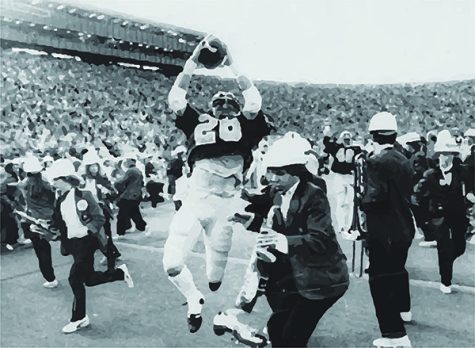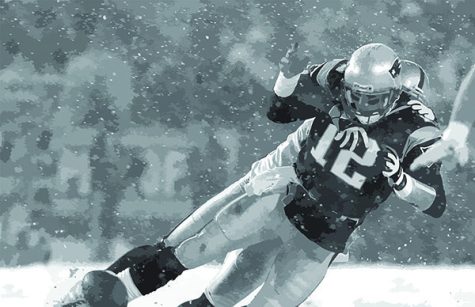The Most disputed Calls in Sports History

Anyone who would proclaim him or herself as an avid sports fan is sure to have seen many cases of objectionable criticism towards calls made by officials. No matter the event, there is nothing more aggravating than a disputable call made against your favorite team. In many sports, there have been countless rulings that have sparked enduring debate and argument. Here are five calls in particular that have been hotly disputed, to the point where they have left a lasting impact on fans, players and the sport itself.
“The Play”
Many local college football fans are aware of the historical football rivalry between Stanford and Cal. Since 1892, the teams have clashed in the Big Game every year, but it was the Big Game on Nov. 20, 1982 that left a tremendous impact on the rivalry and on college football.
Neither of the teams had an especially impressive 1982 season, though Cal was favored with a winning record of 6-4. Stanford had struggled with a record of 5-5, but it had a few memorable wins over great teams such as the Washington Huskies and the Ohio State Buckeyes.
This was also the last regular season for talented Stanford quarterback John Elway.
For Stanford, a win meant bowl eligibility — most likely to an invite to the Hall of Fame Bowl. Cal was already bowl eligible, but had not received any invitations.
“The Stanford Axe,” a trophy given annually to the winner of the Big Game, was also at stake.
The suspense surrounding the game steadily increased as the match-up approached. On game day, 75,000 excited fans packed into the stadium for the opening kickoff as the game commenced.
The two teams exchanged possession throughout the first three quarters, with neither team gaining a significant lead over the other. Late into the fourth quarter, Cal pulled ahead 19-17. Stanford was forced to take possession deep into their own territory and was faced with a difficult fourth-and-17 from their own 13-yard line.
Failure to convert a first down would likely end the game, but Elway made a crucial completion for 29 yards.
Inspired by this play, Stanford began to rally, continuing to move the ball effectively downfield, until they reached field goal range.
Elway called a timeout with eight seconds remaining to kick a 35-yard field goal. This allowed Stanford to freeze the clock so that they would have a second chance in case they drew a penalty.
Kicker Mark Harmon successfully made the field goal, putting Stanford ahead 20-19 with four seconds left.
The team began to celebrate, to a point where they received a 15-yard penalty for unsportsmanlike conduct, forcing Stanford to kickoff from further away.
Stanford would have never expected how big of an impact this penalty would have, as they were now forced to kick off from their own 25-yard line rather than the typical 40-yard line.
Harmon squibbed the kick around Cal’s 45-yard line where defensive back Kevin Moen quickly recovered the ball.
Moen scrambled before lateraling leftward to defensive back Richard Rodgers. Rodgers was quickly pressured by Stanford’s defense and pitched the ball back to halfback Dwight Garner.
Garner ran forward, picking up a few yards. He ran into a bundle of Stanford players, and as he was being brought down, pitched the ball back to Rodgers.
Stanford players behind the south end zone began to run onto the field under the impression Garner was down.
Rodgers dodged a defender and found space toward the right. As he sprinted towards the right side, several of his teammates followed closely behind him to offer additional support.
At this point, 140 Stanford band members, also under the same false impression, had joined the players and marched onto the field.
Rodgers made his way to the Stanford 27-yard line before running into a group of defenders. As he was brought down, he made a blind lateral over his shoulder picked up by Moen around the 25-yard line. Moen beat two defenders, but also had to dodge the many intruding band members.
He found his way through the mob into the endzone, where he famously ran into an oblivious trombone player.
The officials ruled it a touchdown and the Cal players celebrated triumphantly, but it was difficult to make a correct call with band members obstructing their view.
The Play has sparked tremendous controversy and discussion — many argue that Garner was down, and that two of the five laterals, especially the one thrown from Garner to Rodgers, were illegally thrown forward. Stanford was also guilty of illegal participation, with too many players and band members on the field.
None of these possible obstructions were called, and Cal won the game 25-20.
The “Hand of God” goal
Considered one of the most controversial goals in soccer history, Diego Maradona’s “Hand of God” goal occurred during the 1986 World Cup when Argentina faced England.
Just four years after the Falklands War between Argentina and the United Kingdom, this match had a far deeper meaning beyond just being a simple sports rivalry.
Once the game began, both teams had exchanged opportunities to score. Argentina appeared to have the upper hand, but it was England goalkeeper Peter Shilton who saved all of Argentina’s close attempts.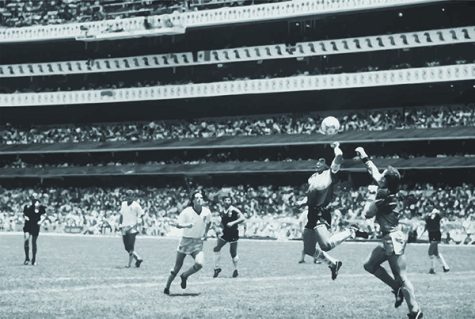
Early into the second half, both teams remained scoreless. Argentina’s Diego Maradona had possession of the ball, and he completed an easy pass to forward Jorge Valdano. Valdano dribbled the ball closer to England’s goal as Maradona made a run toward the penalty box.
Valdano attempted to pass it further downfield to Maradona, but the pass was rejected by an England defender. Fortunately for Maradona, in trying to clear the ball, the defender failed and directed the ball further into the penalty box, close to where Maradona was positioned, and he leaped to head the ball into the goal.
The controversy begins here, as the ball can clearly be seen first hitting Maradona’s left fist, knocking it into the goal. The inexperienced referee Ali Bin Nasser and line keepers failed to see this, and the England players were quick to protest the call.
“I was waiting for my teammates to embrace me, and no one came … I told them, ‘Come hug me, or the referee isn’t going to allow it,’” Maradona said after the match.
However, the call remained, and Argentina went on to win the match 2-1 and later went on to beat West Germany and win the World Cup.
The goal later became known as the “Hand of God” goal after Diego Maradona himself was quoted saying the goal was scored with “a little with the head of Maradona and a little with the hand of God.”
Tom Brady’s “Tuck Rule” game
As the last game to ever be played at Foxboro Stadium, home of the New England Patriots, began, heavy snow covered the turf. It was Jan. 19, 2002, and the temperature was 19 degrees Fahrenheit as the Oakland Raiders faced the New England Patriots in a divisional playoff game. The winner of the match would advance to the American Football Conference (AFC) Championship, which would determine one of the competitors in the Super Bowl.
The Raiders had finished the regular season with a record of 10-6, clinching a spot in one of four wild card games against the New York Jets. The Raiders easily picked up a win, beating the Jets 38-24 and progressed into the divisional playoff game against the Patriots, who were 11-5.
The Patriots had clinched the second seed of the AFC after an eventful season. Following two early losses and veteran quarterback Drew Bledsoe’s sheared blood vessel in the regular season, the Patriots decided to put in their second string quarterback, young Tom Brady. Brady would not only make a name for himself this season, but would also be the focus of one of the most memorable plays in NFL history.
The game began with the surface of the field already laced with snow and even more falling. The Raiders controlled the game through the third quarter by scoring a touchdown and two field goals while only allowing the Patriots three points. Down 13-3 in the fourth quarter with eight minutes left, the Patriots responded as Brady ran into the end zone, minimizing their deficit to three. With the Raiders unable to answer, the Patriots retook possession late in the fourth quarter at their own 46-yard line.
After a successful first down run by Brady, just under two minutes remained. During a timeout, Raiders cornerback Eric Allen heard Brady discussing the next play with the Patriot’s offensive coordinator and quickly went back to his sideline to report what he had heard. The next play, Brady dropped back for a pass, but faced heavy pressure. The defense was fully prepared for the play, and as Brady attempted the pass he realized the receivers were under tight coverage and instead pump faked. As this happened, Brady was hit hard by cornerback Charles Woodson and the ball was knocked loose. The ball was ruled a fumble and recovered at the Raider’s 47-yard line by linebacker Greg Biekert.
Raiders players and fans erupted in celebration. With possession and only one minute and 45 seconds remaining, the Raiders had surely won. However, officials paused the game to review the call. After discussion, the officials overturned the call, reasoning that Brady’s arm was in forward motion when the ball was forced out, making the play an incomplete pass instead.
According to the NFL, the rule regarding fumbles at the time was the following: “When a player is holding the ball to pass it forward, any intentional forward movement of his arm starts a forward pass, even if the player loses possession of the ball as he is attempting to tuck it back toward his body. Also, if the player has tucked the ball into his body and then loses possession, it is a fumble.”
Although this call pertained to passes, many were outraged due to the fact that Brady had clearly tucked the ball into his chest and had no intention of throwing it. Now with little time remaining, the Patriots regained possession for a second chance to survive.
After a 13-yard pass from Brady, the Patriots lined up for a 45-yard field goal. To force the game into overtime, Patriots kicker Adam Vinatieri successfully kicked a field goal with 27 seconds left in the game.
In overtime, the Patriots took possession first. They drove 61 yards in 15 plays, and Brady did not miss a single pass. Stopped on fourth down, Vinatieri once again lined up for a field goal to win the game, this time for 23 yards.
Despite the heavy snow complicating the field goal, Vinatieri split the uprights and the Patriots won the game to advance to the AFC Championship. The Patriots went on to beat the Pittsburgh Steelers in the AFC Championship and advance to Super Bowl XXXVI, where they beat the St. Louis Rams to become champions.
Had it not been for that call, the Raiders would have likely won the game. As a direct result of the game, the rule enforced two years prior was dubbed “The Tuck Rule.” However, the rule was repealed by a 29-1 vote in 2013, proving it only temporary.
USA vs. USSR Gold Medal game 1972
When basketball was first introduced into the Summer Olympics in 1936, the USA Men’s National Team dominated the event. In fact, leading up to the 1972 Olympic games, the American men had yet to lose a game and had earned all seven possible gold medals to date.
In the preliminary round, the qualifying teams split into Group A and Group B. The teams played seven games and the top two teams moved on. USA easily advanced, winning all of its seven games, putting them at the top of Group A.
Meanwhile, USA’s political and Olympic rival, the USSR, had also gone undefeated, placing them at the top of Group B.
America then faced Italy in the knockout round, scoring almost twice as much as Italy in a 68-38 victory.
They met the Soviet Union in the Championship game, playing for the gold medal. As the game began, the USA men were unexpectedly outplayed.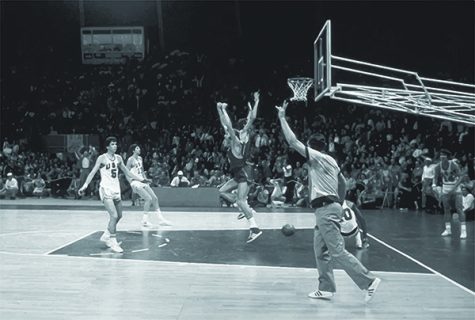
“Unfortunately the Americans were surprised by a team that was better than they ever counted on it being,” Dennis Lewin, producer of the gold medal game on ABC, said.
After the first half of play, America trailed by five. In the second half, the Soviet Union expanded their lead to 10 points with only 10 minutes remaining.
However, America continued to fight, and struck a comeback, which eventuated in a one-point deficit with a mere 38 seconds remaining.
The Soviet Union held possession with under 10 seconds remaining, but an imprudent pass from a Russian player was intercepted by American guard Doug Collins who was immediately fouled.
Under immense pressure, Collins stepped up to take two crucial free throws. Collins drained both of them, putting America in the lead 50-49. USSR inbounded the ball for one final chance, but the game was halted by the referees with one second remaining.
Apparently, the Soviet Union had signaled for a time-out in between the free throws, but the officials had not acknowledged it. Today it is still debated whether or not the time-out was called legally or not.
Three seconds were added back to the clock and the Soviets inbounded the ball for a second time, and as the clock expired the Americans began to celebrate a victory. To everyone’s surprise, the teams were once again ordered back onto the floors.
The officials explained that the floor crew had not reset the clock properly, and the Russian team was given a third chance. The inbound pass soared across the court successfully into the hands of Alexander Belov, who layed it in as time expired.
The Soviet Union defeated America 61-60, marking America’s first loss in eight Olympic tournaments. The Soviets claimed the gold medals; however, American players refused to accept their silver medals.
The American team filed a formal protest to the International Basketball Federation which was later concluded in the Soviet’s favor.
To this day, all of the silver medals still sit in a vault in Switzerland — none of the American players have claimed them.
Armando Galarraga’s near-perfect game
In June 2010, the baseball season was in full swing, and the Detroit Tigers were set to face the Cleveland Indians at Comerica Park in Detroit. Both teams had struggled to begin the season, with the Indians struggling with a 19-32 record and the Tigers also doing poorly, barely sustaining a winning record at 27-25.
Pitching for the Indians was fifth-year pitcher Roberto Hernandez. Hernandez had pitched for the Indians for his whole career, and had a record of 13-14 going into the game. However, it would not be Hernandez whose performance would be remembered for years to come, but Tigers pitcher Armando Galarraga’s. Galarraga had only pitched seven games that year with a mediocre record of 3-4, but in this game, he would come within one out from achieving the 21st perfect game in Major League Baseball (MLB) history. A perfect game occurs when a pitcher does not allow batters to reach any base by any means.
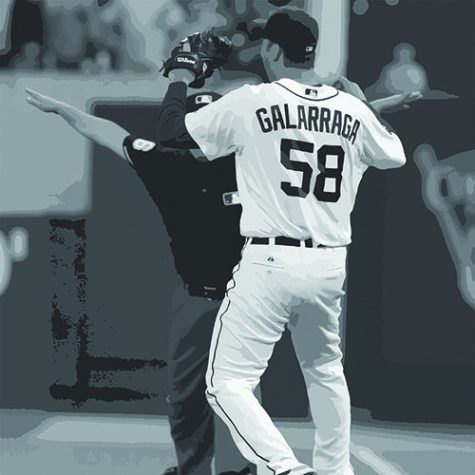 The game began as any other. In the second inning, Tigers first baseman, Miguel Cabrera, homered with no batters on base to boost the Tigers to a 1-0 lead. As the game progressed, players, coaches and fans observing the game began to notice that the Indians players had yet to get on base and that Galarraga had the opportunity to pitch a perfect game.
The game began as any other. In the second inning, Tigers first baseman, Miguel Cabrera, homered with no batters on base to boost the Tigers to a 1-0 lead. As the game progressed, players, coaches and fans observing the game began to notice that the Indians players had yet to get on base and that Galarraga had the opportunity to pitch a perfect game.
Through the eighth inning, the Tigers added two runs from a single by Magglio Ordóñez and a throwing error by Shin-Soo Choo to make it 3-0. However, it was no longer just a win that fans were anticipating, and as the Tigers went into the final inning, Galarraga had yet to give up a single hit.
The first batter, Mark Grudzielanek, was quick to make contact. The ball soared into deep center field where center fielder Austin Jackson made a remarkable over-the-shoulder catch for the first out. The second batter, Mike Redmond, hit a grounder to the infield and was quickly thrown out. With two outs in the ninth inning, the next call would be one of the most infamous calls in MLB history.
The third batter, Jason Donald approached the plate. Donald had watched a strike and a ball go by, resulting in a 1-1 count. Galarraga was only two strikes or one out away from making MLB history. After Galarraga delivered the third pitch, Donald grounded the ball in between first and second base. First baseman Miguel Cabrera darted toward the center of the bases to collect the grounder.
Meanwhile, Galarraga awaited the throw from Cabrera. The throw was quickly delivered to Galarraga’s glove just before Donald stepped onto the base. To everyone’s surprise, Jim Joyce, the first base umpire, called the runner safe. The crowd burst into angry booing after the replay exposed Joyce’s error.
“It was the biggest call of my career, and I kicked the s**t out of it,” Joyce said. “I just cost that kid a perfect game.” He later approached Galarraga with tears in his eyes and apologized.
Galarraga was disappointed yet understanding.
“You don’t see an umpire after the game come out and say, ‘Hey, let me tell you I’m sorry,’ “ Galarraga said. “He felt really bad. He didn’t even shower.”
Your donation will support the student journalists of Palo Alto High School's newspaper

